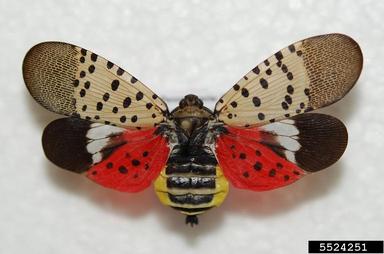Apr 25, 2022Missouri growers urged to watch for spotted lanternfly
While not yet detected in Missouri, spotted lanternfly remains a concern for vineyards, certain trees and specialty crops as it continues to spread west.
If spotted lanternfly (SLF) reaches Missouri, early detection and insecticide control measures will be key to reducing the economic damage, said Dean Volenberg, viticulture Extension professor with the University of Missouri Grape and Wine Institute.
“What appears to be the most damaging is the initial invasion of SLF,” Volenberg said. “But now we have control measures that should help mitigate economic damage from the pest.”
When SLF initially invaded vineyards in Berks County, Pennsylvania, in 2014, it inflicted extensive damage, even causing some grapevine death the following season.
“Adult SLF in vineyards will likely be found from July through December, when it will be important to inspect equipment such as tractors, sprayers, mowers, harvesters and even vineyard workers’ vehicles prior to movement to other vineyards,” Volenberg said.
Since its discovery in Pennsylvania, SLF has been reported in 10 more states: New Jersey, New York, Delaware, Maryland, Virginia, Connecticut, Massachusetts, Indiana, Ohio and West Virginia, according to the USDA.
In September 2021, a single specimen of spotted lanternfly turned up at the Kansas State Fair as part of a participant’s insect collection. The specimen was collected from a back porch that spring and was reported to be very tattered. It is believed the lone specimen may have “hitchhiked” into Kansas by car, train or some other vehicle.
Of more concern is a July 2021 report out of Indiana, Volenberg said. An infestation of spotted lanternfly was discovered in a wooded area in the town of Vevay, 330 miles east of St. Louis.
As spotted lanternfly moves westward, grape growers and the general public need to remain vigilant and report potential sightings, he said.
Sarah Phipps, state survey coordinator for plant pest control at the Missouri Department of Agriculture, said surveyors across the state have been checking for spotted lanternflies. “Thankfully, we have not found any in Missouri,” she said.
The spotted lanternfly is a planthopper in the order Hemiptera, or true bugs, which also includes cicadas, brown marmorated stink bugs and aphids. A distinguishing feature of the spotted lanternfly is a piercing-sucking mouthpart for penetrating into the plant’s phloem to withdraw the sugary sap.
Spotted lanternfly has four nymphal stages, an adult stage and an overwintering egg mass. There is one generation per year. Egg masses are laid in roughly 1-inch segmented rows that are often covered with a grayish putty-like substance. The egg masses can be found on many hard surfaces, both natural and artificial.
What if you encounter what you suspect is a spotted lanternfly? Take a photo, making sure the specimen is in focus, collect the insect, and email the photo and the location to [email protected].















